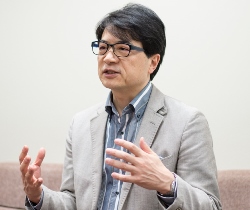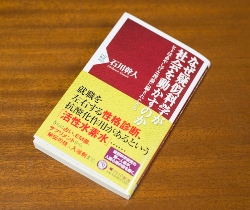Pseudo-science is born from the “scientific mind”

From the prehistoric past, when our ancestors lived by hunting and gathering, people have found patterns in the phenomena they experienced, used these patterns for prediction of the future, and so made them benefit their life. For example, our ancestors learned that they could harvest taros if they dug under the right plants three days and nights after their flowers fell and the stalks had withered. Regular patterns were established after a process of trial and error, and could be used as reliable theory. This is the origin of what we now call science.
Today as well, upon the emergence of new theories and technologies, many scientists engage in discussion about whether or not they will really hold water, and make repeated tests and verifications for a period of 10 or even 20 years. The theories and technologies are only announced to the public when it is virtually certain that they work. This is the proper scientific method of seeking “reliable theory.” This also applies to the gravitational waves that have attracted so much interest lately. After Einstein predicted their existence, repeated trial-and-error testing of all sorts continued for a period of 100 years before scientists finally succeeded in making a definitive observation of them.
In some cases, however, information spreads among the general public before the science has been fully verified. Theories that appear to be scientific on the surface but have not been fully verified are called “pseudo-science” and not included in the sphere of genuine science.
Let us consider why pseudo-science ends up being believed by many people and spreading in society.
Using the human “tendency to believe”
People learn from experience. Anyone who succeeds at something in some way will try to apply it again the next time. And if they succeed again… They may tell those around them about their experience of success. Once this happens, what happened to succeed only by coincidence may widen in application as a pattern that everyone will consider a successful one. This is because people are liable to believe even what are merely personal views of others, if they think these views are accepted as common sense by society in general.
This tendency is deeply rooted in our minds. The reasons is that, in prehistoric times, people evolved by imitating the behavior of and cooperating with those around, in order to survive. Research in recent years has revealed the existence of “mirror neuron” cells in the brain. These cells act as if their owners had done a certain behavior merely by watching the behavior of another. This is said to be at the foundation of human empathy and harmony. Advertising that features talked by fans of a certain product about their experience with it plays on this human tendency.
If a superficially logical explanation is added, the claim becomes even easier to believe. An explanation about why collagen is good for keeping skin beautiful may mention the structure of the body or function of collagen. It may point out, for example, that collagen plays the role of preserving skin tissue structure and elasticity. This is liable to make people think that the intake of collagen has been scientifically proven to be good for the skin. Nevertheless, there is basically no guarantee that, just because you have eaten collagen, it will be absorbed inside the stomach and intestines, and from there transported in the same form to the skin, where it will deliver the desired effect. The resynthesis of collagen you have eaten into skin collagen is nothing more than wishful observation. Businesses that want to sell collagen never include such negative logic in their explanations.
Scientists may also “go too far”

In addition, there are some scientists who will make claims to the general public about things that are still at the research stage. Properly speaking, it is important for research results to be introduced in scientific journals or other such publications, so they can be further verified by researchers around the world. The researcher may be confident about his (or her) theory and want to announce it as soon as possible. Similarly, some reporters in the mass media are aiming for a scoop and eager to hype the story and make a big splash with it. Such treatment can lead the general public astray and even do damage to certain industries.
Some years ago, there arose plausible rumors that dairy milk was not good for you. This led to a decline in milk sales and did significant damage to dairy farmers in Japan. However, an examination found that the theory of the physician who propounded this view was not properly constructed, and did not obtain enough data to support it, either. The diffusion of theories as if they are scientifically evident before they have been scientifically proven is a major problem.
Science communication to support scientific attitudes

To seek data proving the theory is a good way to prevent the general public from being led astray by pseudo-science. If the subject is a product, it would be a good idea to ask the manufacturer if there are data to back up the claims made in ads and other places. In fact, there are all sorts of restrictions on advertising indications. In some cases, the manufacturer cannot present certain data in ads even if it wants to. In response to such an inquiry, the manufacturer may be glad to present data, almost as if it had been waiting for the opportunity. Conversely, if the manufacturer is reluctant to present data, it may mean that the grounds of its claims are shaky.
In light of this situation, the Foods with Function Claims system was instated in 2015. This system covers foods as a whole, including health foods and supplements. Under it, companies can clearly label their products as “function foods” and display functional indications for them, provided that they supply information serving as the grounds for claims about safety and efficacy to the national Consumer Affairs Agency. The information they supply is disclosed on the Agency website. Although some media representatives take up the disclosed information or data and point out problems with them, the focus now should be on those products for which such data have not been provided. In the first place, I see a need for a general widening of the idea to “refrain from purchase of supplements for which backing data have not been provided.”
For the ordinary person, it would be extremely difficult to acquire the requisite scientific knowledge, but anyone can adopt a “scientific attitude” of seeking logical confirmation. It is vital for us to make such an attitude our own, so that we are not led astray by pseudo-science.
I, too, put out a book titled “Why does Pseudo-Science Sway Society” (published by PHP Shinsho) in February of this year. In it, I included a detailed description of ways of detecting pseudo-science. In addition, the Meiji University Science Communication Laboratory has launched a “website for scientific assessment of subjects thought to be cases of pseudo-science.” It is the aim of the Laboratory to assess the scientific soundness of various cases, engage in question-and-answer discussion not only with members of the general public but also people in business, and thereby raise the level of awareness. I believe that is what “science communication” means to us. We are determined to continue taking action for the widespread permeation of a scientific attitude.
* “Why does Pseudo-Science Sway Society?” (PHP Shinsho)
Main contents: ●The truth about sleep paralysis ●Why do people believe in amulets? ●Even astronomy has occult origins. ●Beware of sham advanced science! ●“Professional secrets” and scientific technology ●Media, government, and scientists.
* The website for scientific assessment of what are thought to be cases of pseudo-science, operated by Meiji University Science Communication Laboratory (https://gijika.com/)
Major items assessed so far: ●Supplements (DHA/EPA, hyaluronic acid, etc.) ●Alternative folk remedies (magnetic induction therapy, acupuncture, etc.) ●Life environment improvement (active hydrogen water, hot-spring therapy, etc.) ●Self-enlightenment (personality evaluation based on blood type, palmistry, etc.) ●Mysterious phenomena (ESP, UFOs, etc.) ●Claims about safety (claims about the hazards of electromagnetic waves and dairy milk)
* The information contained herein is current as of March 2016.
* The contents of articles on M’s Opinion are based on the personal ideas and opinions of the author and do not indicate the official opinion of Meiji University.
Information noted in the articles and videos, such as positions and affiliations, are current at the time of production.

